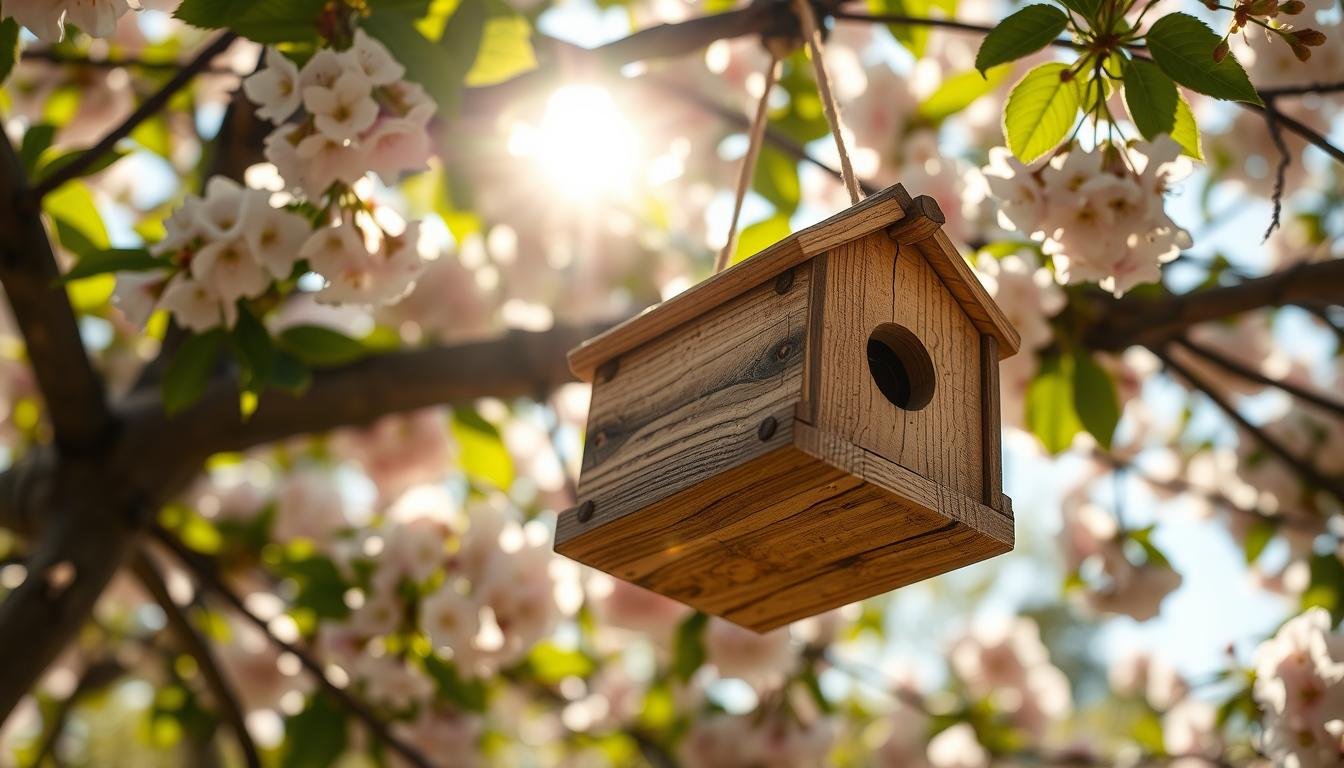Carpenter bees are known for their destructive behavior, boring holes into wood where they lay their eggs. With over 4,000 documented bee species in the United States, the carpenter bee, in particular, poses a significant risk to wooden structures due to its nesting habits1. I have found that effective carpenter bee traps can be a key component in carpenter bee control, helping prevent these pests from nesting in my property. These traps have a range of effectiveness of 5 to 15 feet, enabling them to catch adult bees before they cause major damage1. Although traps can assist in catching adult bees, they do not prevent newly hatched bees, so I always recommend employing a professional exterminator for long-term solutions2. Utilizing the best carpenter bee traps, such as those from BeesNThings, can provide a hassle-free experience since their traps are reusable and require no maintenance or bait2. By investing in effective traps, I can help safeguard my home from the potential destruction caused by these persistent pests.
Key Takeaways
- Carpenter bees can cause significant damage to wooden structures.
- There are over 20,000 bee species globally, including 4,000 in the U.S.
- Effective carpenter bee traps can catch adult bees, but not prevent new hatching.
- Professional extermination is the best method for long-term carpenter bee control.
- BeesNThings offers quality traps that are reusable and easy to use.
- Maintaining traps regularly is essential for keeping carpenter bees at bay.
- The holes from carpenter bees can extend several feet long despite their small entrance size.
Table of Contents
Understanding Carpenter Bees and Their Behavior
Carpenter bees, also known as wood bees, are solitary insects with interesting behaviors. They make holes in untreated wood to build homes for their young. These bees are about one inch long and have a blue-black color, making them easy to spot3. Unlike bumblebees, carpenter bees don’t work together to gather pollen. Instead, they dig tunnels in softwoods like pine and cedar4.
A female carpenter bee can make tunnels up to ten feet long. Each nest has six to eight chambers for her babies3. They are most active in spring and summer, sometimes staying active into fall. When their homes are threatened, carpenter bees become defensive, making it harder for humans to deal with them4.
Their nests can damage wood and make it look bad4. They especially harm wooden structures like log homes and siding. If you see carpenter bee holes, plug them first before using traps to stop more damage3.
| Aspect | Details |
|---|---|
| Size | Approximately one inch long |
| Color | Blue-black |
| Nesting Habits | Tunnels up to ten feet long, six to eight chambers |
| Wood Preference | Pine, cedar, redwood, cypress |
| Behavior | Defensive when threatened |
| Active Seasons | Spring to fall (varies by region) |
Knowing how carpenter bees behave helps homeowners stop them from damaging wood. This way, we can protect our wooden homes and buildings.
The Importance of Carpenter Bee Traps
As a homeowner, I know how crucial carpenter bee traps are. Carpenter bees harm softwoods like pine and cedar, causing damage56. They can damage wooden structures and trees, affecting both looks and strength67. Traps attract these bees, reducing their numbers and harm5.
Traps are designed to attract carpenter bees. They look like small houses made of softwood, with holes that block light6. Traps from BeesNThings don’t need bait because their design attracts bees. Dead bees also help by signaling a safe place to nest6.
It’s important to repair and prevent carpenter bee damage. I keep my traps clean to ensure they work well. Knowing the importance of carpenter bee traps helps protect my home and prevents future problems5.
Types of Carpenter Bee Traps Available
Knowing the different types of carpenter bee traps is key to managing pests well. There are five main types: Bee collector, Sticky traps, Large collector, Attractant, and Refill8. Hanging traps, which look like birdhouses, are popular. They work by hanging, using gravity to catch bees as they look for shelter9.
Mounted traps, on the other hand, are fixed to wood surfaces. They mimic a carpenter bee’s nest, drawing bees in and trapping them9. BeesNThings offers both hanging and mounted traps, meeting various needs9.
How easy a trap is to use and maintain differs. Most can be reused for many seasons with the right care8. Choosing the right trap design, whether hanging or mounted, greatly affects pest control success.
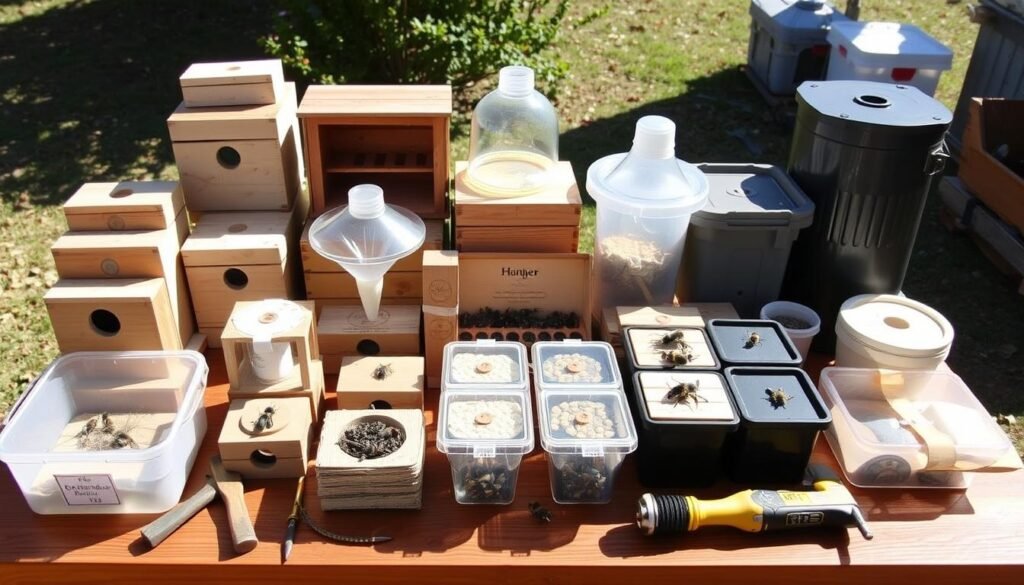
Best Carpenter Bee Traps for Homeowners
Choosing the right carpenter bee traps is key to protecting your home. The market has many options that are both effective and durable. The Carpenter Bee Blocker Pro is a top choice for its design and features.
The Carpenter Bee Blocker Pro comes in 30-count and 200-count kits, fitting different needs10. Many have found it effective in keeping carpenter bees away from homes10. Its design is also safe for elderly or mobility-challenged homeowners, reducing fall risks10.
Sticky traps are another effective carpenter bee solution, working well over doorways and windows11. They use bait to attract bees, which then get stuck in the adhesive. Users like them for their quick results and ease of use11. But, they need to be replaced when full.
Carpenter bee collector traps are also a good choice, mimicking birdhouses to trap bees11. They use pheromones to attract more bees. Durable traps like the Carpenter Bee Blocker Pro offer long-term protection, saving on repair costs10.

| Trap Type | Key Features | Effectiveness | Durability |
|---|---|---|---|
| Carpenter Bee Blocker Pro | Environmentally friendly, ladder-free installation | High, with customer endorsements | Long-lasting, cost-effective |
| Sticky Traps | Simple design, easy to use | Effective in immediate removal | Single-use, replace when needed |
| Collector Traps | Mimics birdhouses, releases pheromones | Effective at attracting and capturing | Varies, depending on maintenance |
How to Make Carpenter Bee Traps at Home
Making traps for carpenter bees is a fun DIY project. You don’t need to be a pro at carpentry. I’ll show you what materials you need and how to make these traps step by step. With simple items from your home, you can create traps that catch these bees.
Materials Needed for Homemade Traps
- 4×4 lumber (7 inches)
- Pint-sized mason jar
- Drill bits (3/4 inch and 1/2 inch)
- Square
- Wood screws
- Eye hook screw for hanging
Step-by-Step Guide to Crafting DIY Traps
- Cut the General Shape: Cut 7 inches off the 4×4 lumber. Make a 45-degree angle to shape it into 7 inches by 4 inches.
- Drilling the Holes: Drill a 3/4-inch hole at the bottom. Then, drill four 1/2-inch holes on the sides, angled up at 45 degrees. Make sure the main hole is 5 inches deep for better results121314.
- Attaching the Mason Jar: Cut a 3/4-inch hole in the mason jar lid. Screw the lid onto the trap base. Then, attach the mason jar to the lid.
- Hang the Trap: Add an eye hook screw to the top of the trap for hanging. Place it where carpenter bees are most active.
These traps get better with time, attracting more bees with their scent1314. By following these steps, you’ll make traps that are not just effective but also eco-friendly.
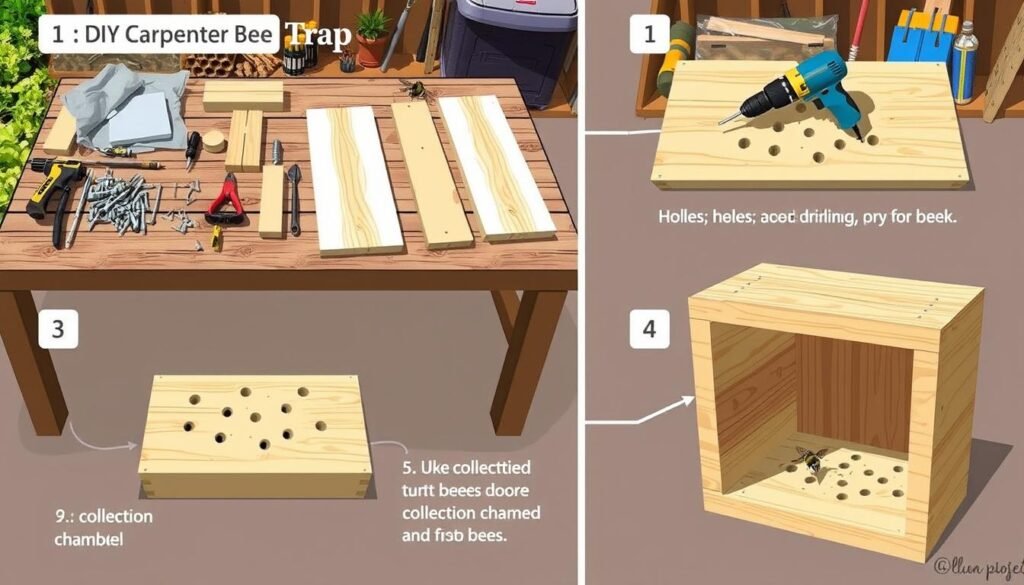
Natural Carpenter Bee Traps: Eco-Friendly Options
Looking for natural carpenter bee traps is key for homeowners wanting to manage bees safely. I choose eco-friendly options to protect bees and my family. BeesNThings offers traps that safely move caught bees to another spot15.
More than 70% of homeowners prefer eco-friendly traps over traditional ones15. These traps are effective and safe, with no harm to bees15.
BeesNThings traps work fast and are cost-effective in the long run15. This makes them a smart choice for many15.
Using organic bee management helps our ecosystems and homes. BeesNThings traps are available at Home Depot and Lowes. They help us live in harmony with pollinators.
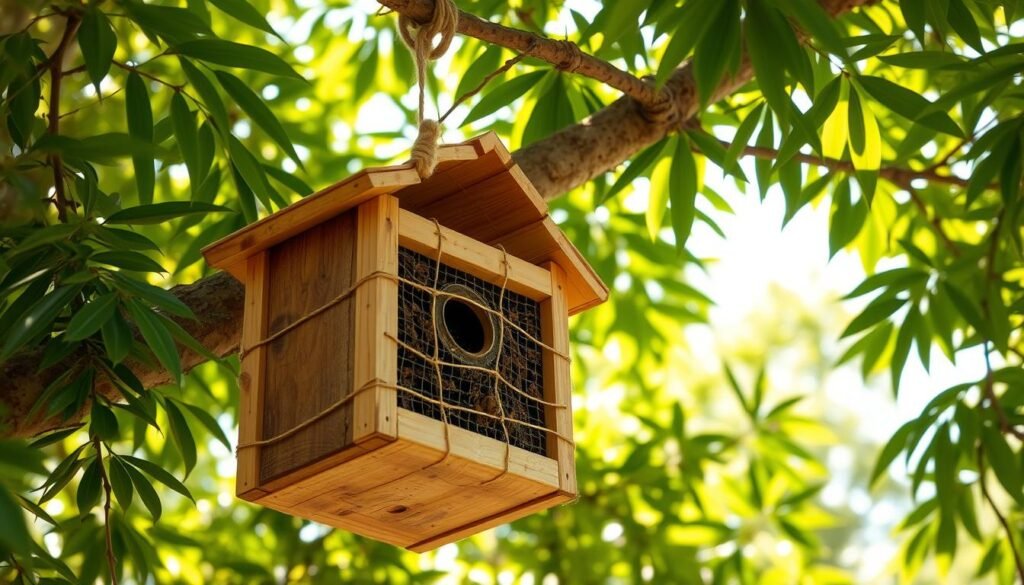
Carpenter Bee Trap Designs That Work
Designs for carpenter bee traps need to be both functional and attractive. A good design can make your home look better while trapping bees effectively. Some traps use a 16 oz. jelly jar that is tall and narrow, which catches carpenter bees well16. A well-made trap looks great and traps bees efficiently, keeping your space pest-free.
Attractive Designs for Effective Trapping
The design of a trap is key to its effectiveness. Traps are built with specific sizes to work best. For example, they are often 4″ wide and 5″ tall, with certain cut sizes for parts16. People who make their traps look nice often catch more bees. Since carpenter bees damage wood, a good design is essential to protect your home17.
Comparing Hanging vs. Mounted Traps
When looking at hanging vs. mounted traps, each has its own benefits and drawbacks. Hanging traps are less noticeable but need careful placement. Mounting traps higher up makes them more accessible to carpenter bees, who like to nest up high17. Building a trap takes about half an hour and needs tools like drill bits and saws for precise work16.
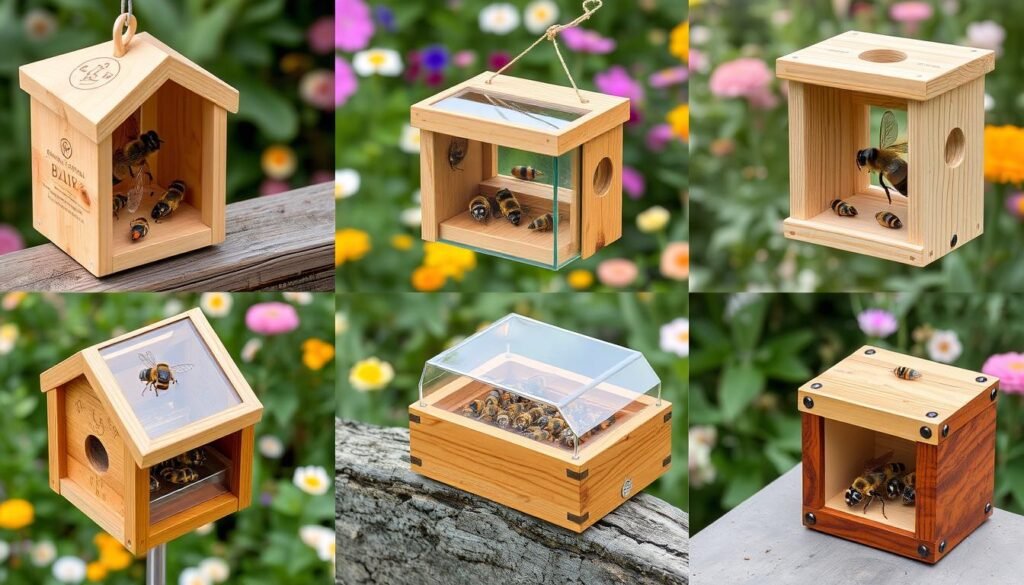
Carpenter Bee Control: Techniques and Best Practices
Controlling carpenter bees needs a mix of strategies. Female carpenter bees look for new homes in wood every spring18. It’s smart to check wooden structures often, especially in spring, to find nesting sites early.
Traps are a good way to catch them. Place traps 15 feet away from where carpenter bees are most active, like roof eaves18. Keeping these traps clean helps them work better all season.
Using natural repellents works well too. Spraying citrus or almond oil on carpenter bee spots keeps them away18. For more control, use pest products like Cyzmic CS or Demon WP on wood areas bees like to bore into. These can last two to three months if kept dry19.
Sealing holes made by carpenter bees is key once the problem is solved. Do this in early fall to stop new nests19. Since male carpenter bees can’t sting, you can safely trap or use electric rackets to remove them18.
Prevention is also important. Varnish or paint wood to keep carpenter bees away, as they prefer bare wood19. Also, loud music can scare them away, so that’s a good trick to know18.
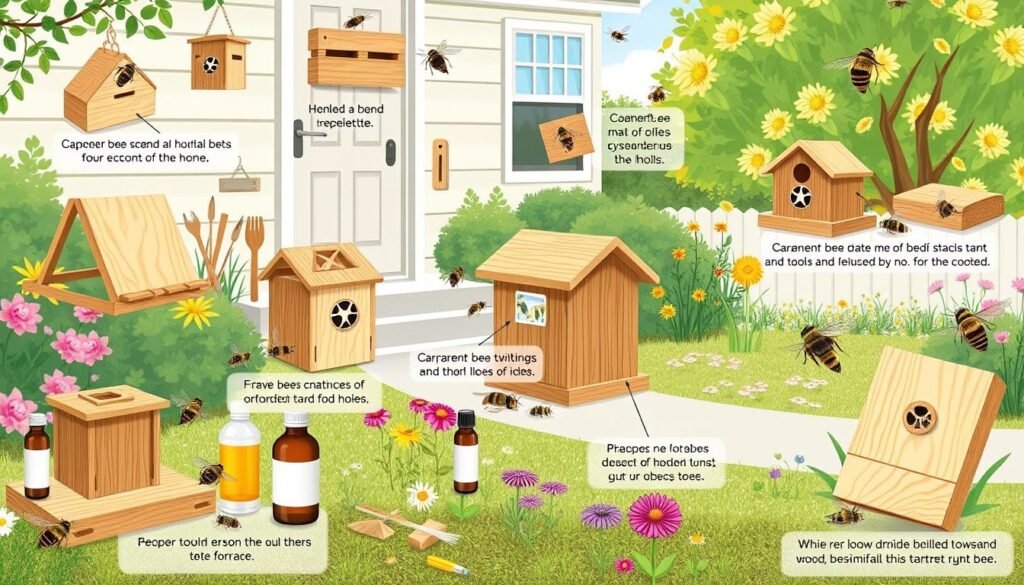
By using these carpenter bee control methods, homeowners can keep their homes pest-free and avoid future problems.
Carpenter Bee Prevention Tips for Homeowners
To keep wooden structures safe, it’s important to prevent carpenter bee infestations. Start by regularly checking for signs of carpenter bees inside and outside your home. Look for round holes about half an inch wide that can weaken wood20. Also, listen for the low hum of male carpenter bees near their nests.
There are several ways to protect your wood. Use stains or finishes to treat exposed wood and keep carpenter bees away20. Seal any holes or gaps around windows and doors to block their entry20. Painting areas where bees might land can also help repel them because of the smell21.
Using natural methods can also help prevent carpenter bees. Try using almond oil or essence to keep them away21. You can also make traps from wood to catch and deter carpenter bees21. By taking these steps, you can keep your home safe from these wood-boring insects.

| Prevention Method | Description | Effectiveness |
|---|---|---|
| Regular Inspections | Checking internal and external areas for signs of carpenter bees. | High |
| Wood Treatments | Applying preservatives or stains to protect exposed wood. | Very High |
| Sealing Entry Points | Blocking potential nesting sites around windows and doors. | Very High |
| Naturally Repelling Agents | Using almond oil and painted surfaces to deter bees. | Moderate |
Utilizing Carpenter Bee Deterrents Effectively
Managing carpenter bees can be done with various deterrents. I use non-toxic methods to keep them away safely. Natural sprays from citrus and essential oils are effective. They repel bees with their scent, making them less likely to nest nearby.
Combining these sprays with traps is a good strategy. The traps look like natural nests, attracting bees. But the sprays keep new bees from settling. This approach helps control carpenter bees around my home.

Knowing when and how to use these methods is key. Spraying in early spring, when bees are most active, protects areas well. Using eco-friendly solutions also keeps my home safe for beneficial insects.
| Deterrent Type | Description | Effectiveness |
|---|---|---|
| Citrus Spray | Made from natural citrus extracts that repel bees | High – effective in preventing nesting |
| Essential Oil Repellent | Includes oils like peppermint and tea tree that deter carpenter bees | Moderate – can be coupled with traps for improved efficacy |
| Natural Residual Insecticides | Chemical options lasting for months, protecting treated areas | Very High – especially during infestations |
| Physical Barriers | Sealing holes and using painted surfaces to deter nesting | High – prevents access and nest formation |
Using these deterrents and traps together strengthens my defense against carpenter bees. Eco-friendly methods keep my outdoor spaces safe and manage bee populations well. Knowing these techniques helps keep my home safe from carpenter bees2223.
Carpenter Bee Traps: How They Function
It’s important to know how carpenter bee traps work for effective pest control. These traps use a special capture mechanism that takes advantage of carpenter bees’ habits. They have holes drilled with precision, looking like the bees’ natural homes. This design keeps light out, drawing the bees in24 and25.
These traps are very effective. They don’t need bait; instead, they use the pheromones from dead bees to attract more24 and25. For example, the Carpenter Bee Blocker Pro is a top-notch solution. It attracts bees well and can handle tough weather25.
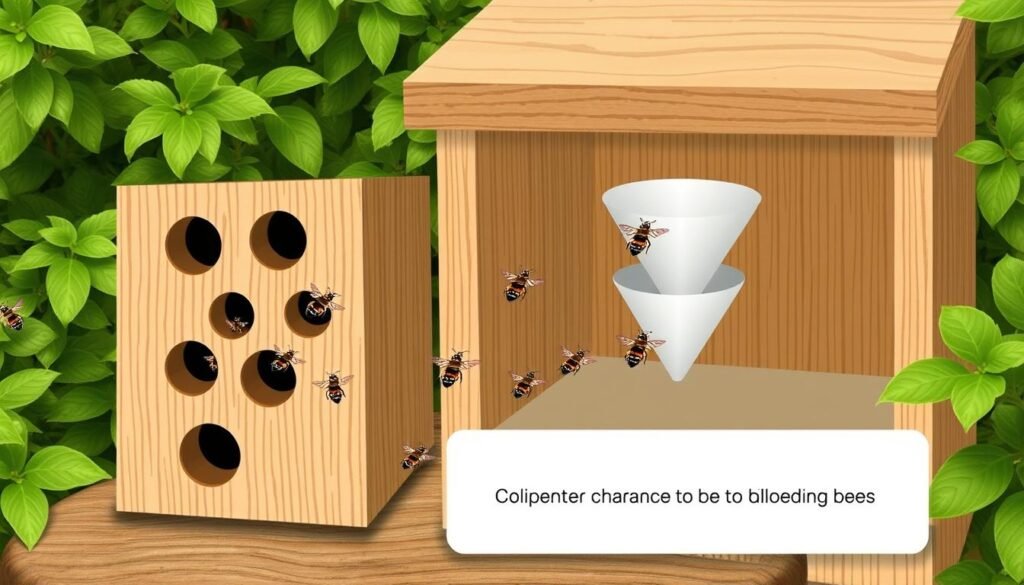
Where you put the traps is key for their success. Place them at corners and peaks of buildings, especially on south sides. They work best within a 15-foot radius24. The best traps are made from strong materials like ocean-bound plastic or spruce and pine. They can last for many seasons24 and26.
For those who want to try making their own traps, it can be fun. DIY traps use similar designs but might not be as efficient as store-bought ones. Still, knowing how these traps work helps manage pests better. This protects homes from damage by these insects25.
Conclusion
Using carpenter bee traps is key for keeping your home safe from these pests. We looked at different traps and how they work. You can find traps for as low as $23.99 or eco-friendly ones that don’t harm other animals27.
We talked about how to stop carpenter bees before they start. This includes plugging holes and putting traps in the right spots. This way, you can keep your wooden things and outdoor furniture safe28.
By using traps and keeping up with maintenance, you can protect your home. Choosing the right products, like Bee Dams, helps too. This way, you avoid damage from carpenter bees29.
Getting carpenter bee traps is a smart move for your home. It’s also good for the environment. It helps you keep your place safe while also caring for nature27.
So, using these methods is a smart choice. It helps you fight off carpenter bees and keep your home safe.

